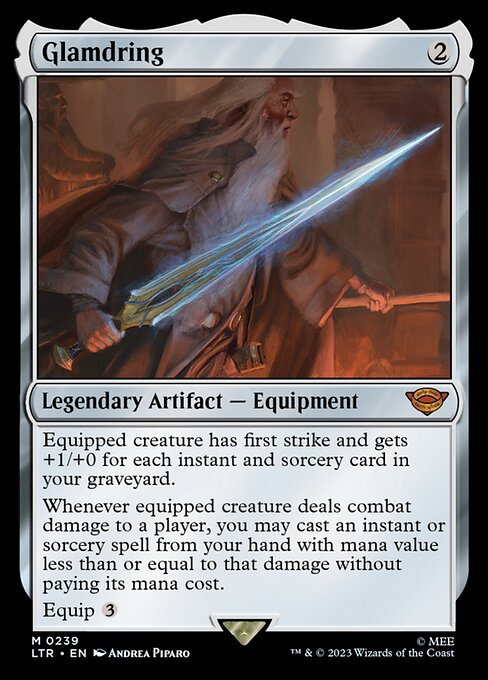
Image courtesy of Scryfall.com
Glamdring and the Narrative of Spellcraft
In the vast storytelling tapestry of Magic: The Gathering, composition does more than determine what sits on the battlefield—it invites you into a moment, a mood, a memory. Glamdring, the mythic artifact equipment from The Lord of the Rings: Tales of Middle-earth, is a masterclass in that invitation. With a lean mana cost of {2} and an equip cost of {3}, this card asks you to think not just about power, but about the stories you want to tell as you deploy it. 🧙🔥💎
The card’s text reads like a mini saga condensed into rules text: “Equipped creature has first strike and gets +1/+0 for each instant and sorcery card in your graveyard.” That is a narrative engine—the more instants and sorceries you bury in the graveyard, the sharper Glamdring becomes. Then comes a twist of tempo: “Whenever equipped creature deals combat damage to a player, you may cast an instant or sorcery spell from your hand with mana value less than or equal to that damage without paying its mana cost.” The moment that blade lands a hit, a spark of magic erupts from your hand, unshackling a spell for free. It’s not just math; it’s a dramatic beat in your deck’s story. ⚔️🎨
What composition teaches us about card storytelling
The beauty here lies in the juxtaposition of a colorless weapon with a tale that thrives on color and memory. Glamdring’s lack of color identity makes it adaptable—an unpinned narrative thread you can weave into almost any color pie that can reliably populate its graveyard with instants and sorceries. The rules encourage you to frame your deck as a memory archive: every discarded spell becomes fuel for your blade, every attacking moment a gateway to a new chapter. In this sense, the card’s composition mirrors Gandalf’s own approach to knowledge and cunning—minimal cost, maximum narrative payoff. 🧙♂️💎
From a design perspective, Glamdring showcases thoughtful typography and economy of words that readers of Scryfall will recognize as deliberate craft. The two-part text creates a rising arc: a persistent buff that builds as the graveyard grows, followed by a decisive burst when you land combat damage. The arc is a micro-story about momentum, risk, and storytelling through play patterns—an ideal example of how a single card can shape a table’s shared fantasy. The art direction by Andrea Piparo reinforces this, with a gleaming blade silhouetted against a runic backdrop, signaling that history and magic are joined at the edge of the steel. 🧙🔥
Deck-building guidance: turning story into strategy
If you’re curious how to weave Glamdring into a coherent table narrative, here are practical prompts to guide silhouette, tempo, and tale:
- Populate the graveyard with instants and sorceries—think cheap draws, counters, removal, and bounce—to maximize the blade’s buff over time. The more fleeting spells you stash, the stronger the equipped creature becomes. 🎲
- Choose a sturdy, aggressive creature to carry Glamdring and take advantage of first strike from the outset. A well-placed strike can set the stage for a memory-rich follow-up spell when the damage lands. ⚔️
- Build a flexible endgame: the free-cast clause from damage lets you script a surprise moment—draw a new answer, flash in a removal, or deploy a finisher when your opponent least expects it. The story pivots on that single spark. 🧨
- Balance tempo and value with cantrips and low-cost spells to maintain ongoing pressure while Glamdring grows. A thoughtful mix keeps your narrative clean and repeatable, even in slower formats. 🧭
“A weapon that turns memory into magic—that’s how a good story lands on the battlefield.”
This sentiment resonates with Glamdring’s core—composition as narrative engine. The card invites you to narrate a turn-by-turn arc where your graveyard becomes a reservoir of options, and each swing unlocks a new page. The set’s draft_innovation framing and its Universes Beyond tie-ins invite players to imagine a larger Middle-earth beyond the battlefield, where lore and lore-friendly design collide in satisfying, story-forward ways. 🎲
Art, lore, and the collector’s gaze
The illustration by Andrea Piparo carries the mythic heft you’d expect from a weapon associated with hobbits, wizards, and epic quests. The card sits comfortably in The Lord of the Rings: Tales of Middle-earth, a set that leans into narrative cohesion as much as mechanical novelty. Its mythic rarity signals a centerpiece pick for many decks, elevating both play and collectability. If you’re tracking value, you’ll notice Scryfall’s data hints at a market that values these stories—foil copies, for example, tend to showcase extra glow on the blade and in the runes. The tale remains evergreen across formats like Modern, Historic, and many eternal horizons. 🎨💎
In the broader MTG ecosystem, Glamdring demonstrates how a single artifact can anchor a theme—story-first—without sacrificing mechanical depth. The card’s design encourages players to embrace the story while optimizing their lines, a balance that keeps the table invested and the game moving with elegant momentum. The glow of the blade isn’t just visual; it’s the cue that every spell you cast in response to a swing adds a sentence to the card’s living narrative. 🧙♂️
As you map out your own table’s saga, consider how a simple equipment card can become a storytelling fulcrum. Glamdring asks you to collect moments—the damage, the flash of a free spell, the grin of a tricksy play—then string them into a coherent arc that feels bigger than the sum of its parts. That’s the art of composition in MTG: turning card text into a living, breathing story you and your friends tell together at the table. 🎨🎲